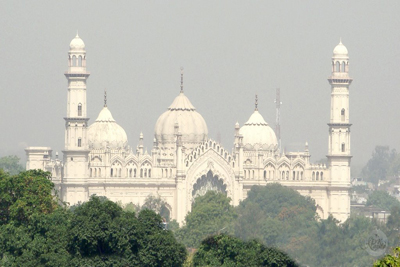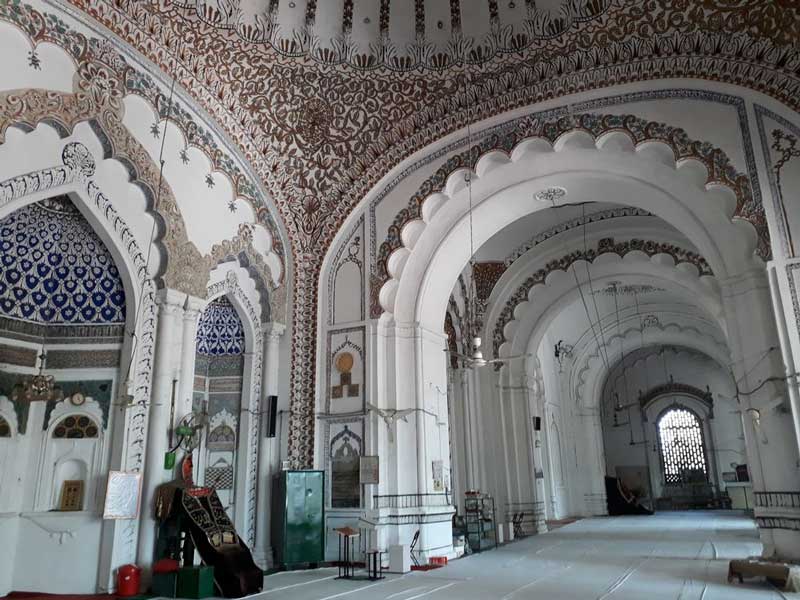
The word Jama is derived from the Arabic word Jummah, which stands for Friday and since the 7th century, the term Jama Masjid stands for the community mosque used by the Islamic world for congregational prayer observed on Fridays. Obviously, there are numerous mosques around the world bearing the same name and its variants, like the marble and red-sandstone structure of the Jama Masjid, located near the massive Red Fort in Old Delhi, India.
Standing proudly on a square, lofty terrace in the Husainabad area of Lucknow in India, the splendid Jama Masjid with its own unique charm is considered one of the oldest historical landmarks in the city, signifying the importance of the ruing Nawabs in the region. Despite being compared with Jama Masjid of Delhi (Ref - Jama Masjid Delhi India), it has gained popularity due to its beautiful architectural design, complete with unique intricate artistic workmanship and has become one of the most popular tourist attractions of the old city.

The construction of the Jama Masjid Lucknow was commissioned by Mohammad Ali Shah, the third Nawab of Awadh in 1839, intending to surpass the Jama Masjid in Delhi in size and grandeur. Unfortunately, he did not live long enough to see the completion of his dream project and after his sudden death; the mosque was completed by his wife, Malika Jahan Begum Sahiba in 1845, although the original ambitious plan was curtailed due to a shortage of sufficient funds.

Constructed in the impressive Mughal architecture and built with flat, thin, red, burnt-clay bricks, known as Lakhauri bricks, the structure is plastered with lime and magnificently adorned with stucco motifs, which added a solemn grandeur to the magnificent edifice.
Equipped with a huge courtyard covering an area of 246 by 216.5 feet (75 by 66 m), it has a rectangular prayer hall with a magnificent facade of eleven arches on the west. The central façade, the largest of all, includes an imposing gateway, which rises above the roof in a sharply pointed arch and is decorated with coloured stucco.


Jama Masjid stands straight over 260 ornamented pillars, which also support 15 beautifully designed and decorated domes at various elevations. The prayer hall is crowned by three pear-shaped high double domes decorated with an inverted lotus on the top and is also flanked by two octagonal four-storey tapering minarets on either side, topped by Chhatries, the elevated, dome-shaped pavilions or canopies on the top.
The tomb of Sultan Ahmed Shah, who started to construct the mosque in 1839, can be found on the eastern side of the entrance and an Imambara, known as Imambara Malika Jahan, is situated at the south of this mosque.

The central archway leads to two prayer halls of Jama Masjid, which is a blend of double cusped arches and intersecting arch weaving, which looks like forming a honeycomb pattern over the squinch, the base to receive the spherical dome. The high pillars and the ceilings of the prayer halls are decorated with flowers and foliage. The prayer niche or the mehrab faces at the western showcases Quranic couplets’ calligraphic inscriptions, backed by the decorative stucco work. While the staircase found over the southeastern side of the first hall leads over the rooftop, which offers a clear view of the stucco patterns over the larger domes and balustrades of this mosque, the staircase inside the minarets leads to the stone based chhatri or umbrella installed over the top.

Unfortunately, the first congregation for the Friday prayer in the mosque, scheduled in 1842, was temporarily withheld when a prominent priest Syed Dildar Ali Naqvi of Naseerabad, who was requested to lead the prayer, denied participating due to some payment issue, which was seen between the owner of a certain portion of the land where the mosque was built. However, after the issue was resolved amicably to the satisfaction of the king and landowner, the first congregation was witnessed of a Friday prayer, held in Lucknow Jama Masjid in 1842.

The mosque is connected to a very important chapter of Indian history. During the advent of the First Freedom Struggle against the British rule in 1857, the force of the British East India Company forcibly took control of it and also vacated the people dwelling around it. During that time they also demolished the surrounding walls, along with a lofty gateway, which were never rebuilt.